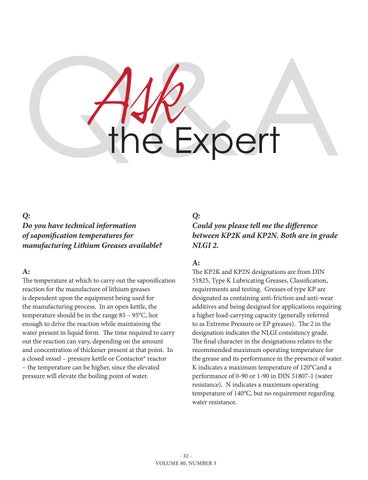the Expert Q: Do you have technical information of saponification temperatures for manufacturing Lithium Greases available? A:
Q: Could you please tell me the difference between KP2K and KP2N. Both are in grade NLGI 2. A:
The temperature at which to carry out the saponification reaction for the manufacture of lithium greases is dependent upon the equipment being used for the manufacturing process. In an open kettle, the temperature should be in the range 85 – 95°C, hot enough to drive the reaction while maintaining the water present in liquid form. The time required to carry out the reaction can vary, depending on the amount and concentration of thickener present at that point. In a closed vessel – pressure kettle or Contactor® reactor – the temperature can be higher, since the elevated pressure will elevate the boiling point of water.
The KP2K and KP2N designations are from DIN 51825, Type K Lubricating Greases, Classification, requirements and testing. Greases of type KP are designated as containing anti-friction and anti-wear additives and being designed for applications requiring a higher load-carrying capacity (generally referred to as Extreme Pressure or EP greases). The 2 in the designation indicates the NLGI consistency grade. The final character in the designations relates to the recommended maximum operating temperature for the grease and its performance in the presence of water. K indicates a maximum temperature of 120°Cand a performance of 0-90 or 1-90 in DIN 51807-1 (water resistance). N indicates a maximum operating temperature of 140°C, but no requirement regarding water resistance.
- 32 VOLUME 80, NUMBER 3









